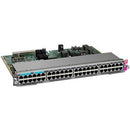Description
The Cisco 48-Port UPoE Expansion Module is a high-density, plug‑in data networking solution designed to scale enterprise and campus networks with remarkable port versatility. Engineered to slot into compatible Cisco switch chassis, this expansion module delivers a balanced mix of 36 RJ-45 10/100/1000Base-T UPoE ports and 12 RJ-45 10GBase-T UPoE ports. It creates a unified Ethernet fabric that supports both traditional Gigabit access and high‑speed 10 Gigabit uplinks, all with Power over Ethernet on every port. This combination enables flexible, scalable network growth while simplifying power delivery to a wide range of devices, from IP phones and wireless APs to cameras and other PoE-enabled endpoints. Built for campus networks, branch offices, data centers, and edge deployments, it provides dense port capacity without sacrificing manageability or performance.
- High-density port mix for flexible deployments. The module combines 36 x 10/100/1000Base-T UPoE LAN ports with 12 x 10GBase-T UPoE LAN ports, enabling a single module to support both legacy devices and next‑gen high‑bandwidth endpoints within a compact footprint.
- Universal Power over Ethernet on every port. UPoE-enabled ports deliver power alongside data, simplifying device deployment and reducing the need for separate power drops while keeping cabling tidy and scalable.
- Flexible data speeds and wide compatibility. Supports multi-rate Gigabit Ethernet on the 36 ports and 10GBASE-T on the 12 ports, ensuring compatibility with a broad range of devices and workloads—from video streaming and IP telephony to high‑bandwidth server uplinks.
- Enterprise-grade reliability with Cisco integration. Engineered for stable operation within Cisco data networking ecosystems and designed to integrate with Cisco management tools and security features for centralized monitoring, configuration, and policy enforcement.
- Future-ready flexibility and deployment simplicity. Modular expansion supports straightforward installation, cohesive cabling, and scalable growth, helping organizations maximize return on investment while maintaining network agility and resilience.
Technical Details of Cisco Expansion Mod
- Port configuration: 36 x RJ-45 10/100/1000Base-T UPoE LAN ports + 12 x RJ-45 10GBase-T UPoE LAN ports.
- Power over Ethernet: UPoE on every port, enabling simultaneous data and power delivery to a wide range of PoE-enabled devices.
- Data speeds: Multi‑rate support with 10/100/1000Base-T on 36 ports and 10GBase-T on 12 ports for flexible throughput across devices and workloads.
- Form factor and compatibility: Plug‑in expansion module designed for Cisco switch chassis; intended for enterprise, campus, and data center environments requiring dense ports and scalable growth.
- Management and integration: Integrates with Cisco management tools, policies, and security features to enable centralized monitoring, configuration, and governance across the network fabric.
- Use cases: Ideal for dense campus deployments, branch offices, edge data centers, and scalable networks where high port counts and reliable PoE are essential.
- Reliability and deployment: Built for enterprise reliability with cohesive integration into Cisco ecosystems to simplify administration and ensure predictable performance.
How to install Cisco Expansion Module
- Verify compatibility: Ensure your Cisco switch chassis supports the 48-Port UPoE Expansion Module and identify the correct installation slot as specified by the chassis documentation.
- Prepare the system: Power down the applicable chassis or follow the vendor’s guidelines for installing field‑replaceable modules if a hot‑swap procedure is supported by your hardware row.
- Remove blank or existing module cover: If necessary, carefully remove the cover or slot filler from the target expansion bay to create an insertion point.
- Insert the expansion module: Align connectors and firmly slide the module into the designated slot until it seats securely. Ensure protective latches engage and the module is firmly seated.
- Connect network cables: Attach 36 ports of 1G/PoE and 12 ports of 10G to your existing devices and uplinks as planned, following standard cabling best practices to maintain organized, label‑friendly racks.
- Power and management: Restore power to the chassis and verify that the module boots correctly. Use Cisco management tools to discover the new module, apply configurations, and monitor port status, PoE budgeting, and health metrics.
- Validation and optimization: Confirm that each UPoE port delivers power to connected PDs, check port speeds, and adjust PoE budgets if necessary to optimize performance and efficiency.
- Documentation and maintenance: Update network diagrams to reflect the new expansion module and establish ongoing monitoring and firmware update plans via Cisco management platforms.
Frequently asked questions
-
Q: How many ports does the Cisco 48-Port UPoE Expansion Module provide?
A: It provides 48 total UPoE ports—36 x 10/100/1000Base-T UPoE ports and 12 x 10GBase-T UPoE ports—delivering a dense, power‑ready Ethernet fabric in a single module. -
Q: What is UPoE, and what practical benefits does it offer?
A: UPoE (Universal Power over Ethernet) delivers greater power over Ethernet cabling than standard PoE, enabling a broader range of devices to be powered directly from the network infrastructure, which can simplify deployments and reduce the need for separate power drops in office or campus environments. -
Q: What deployment environments is this module best suited for?
A: It is ideal for campus networks, branch offices, data centers, and edge deployments that require dense port capacity, scalable growth, and reliable PoE support to power IP phones, wireless access points, cameras, and other PoE-enabled devices. -
Q: How is the module managed within a Cisco ecosystem?
A: It integrates with Cisco management tools and security features, enabling centralized monitoring, configuration, and policy enforcement to maintain consistent performance and compliance across the network. -
Q: Do I need additional power infrastructure when using UPoE on every port?
A: UPoE on every port delivers power through the same copper cabling used for data, potentially reducing the need for separate power drops. However, power budgeting and device requirements should be planned using your network’s PoE policy and Cisco management guidance. -
Q: Can this module be installed in existing Cisco switches?
A: Yes, the module is designed to slot into compatible Cisco switch chassis, enabling seamless expansion without replacing existing infrastructure.
Customer reviews
Showing - Of Reviews


